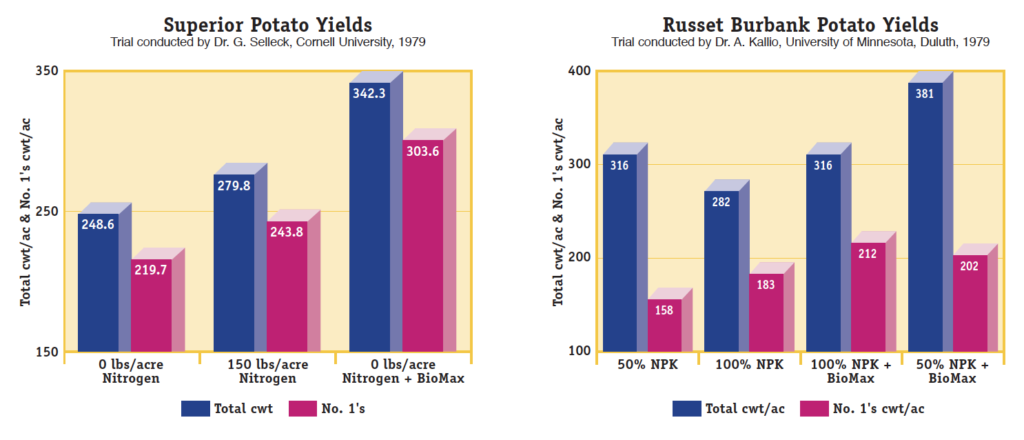BioMax – Helping Nature Work
BioMax is one of the best, most efficient ways to improve soil biology and root environment. BioMax improves soil function in all cropping systems resulting in better root and plant health and increased soil nutrient efficiency.
BioMax is a soil biological stimulator that increases aerobic bacteria (vs. anaerobic) and beneficial fungi, such as ycorrhizae. BioMax contains specific food sources, micronutrients and enzymes that stimulate and increase beneficial bacteria and fungal activity and populations. BioMax does not contain live biological organisms or humic acid, nor is it a “compost tea”. Living biological products are cultured in sterile environments and therefore not adapted to specific soil, crop and environmental conditions, which often limits their longevity and effectiveness. They are also expensive and require proper storage, handling and application preparation. Compost teas require intensive time comsuming over sight, equipment and regulated aeration to ensure efficacy.
BioMax naturally causes a significant increase in beneficial bacteria and mycorrhizal fungi populations that are already in and adapted to the soils on your farm, making them much more effective and consistent.
Ground applied fertilizers – especially phosphate and potassium are rapidly bound up in the soil structure leaving only a small portion of the nutrients available for root uptake. Biological activity is requited to release nutrients from the soil structure. BioMax, by increasing biological populations and activity, maximizes nutrient availability to the roots improving efficiency of ground-applied fertilizers. Enhancing soil nutrient availability can directly increase both crop quality and yield.
How does BioMax™ work?
BioMax increases the native beneficial soil microbial populations for a temporary time period (generally 3-4 weeks). The increase will vary by soil type and conditions but can range from 5-20 times normal population levels. BioMax naturally encourages an increase in native microbial populations. The increase in biological activity results in additional production and release of carbon dioxide and organic acids in the root zone.
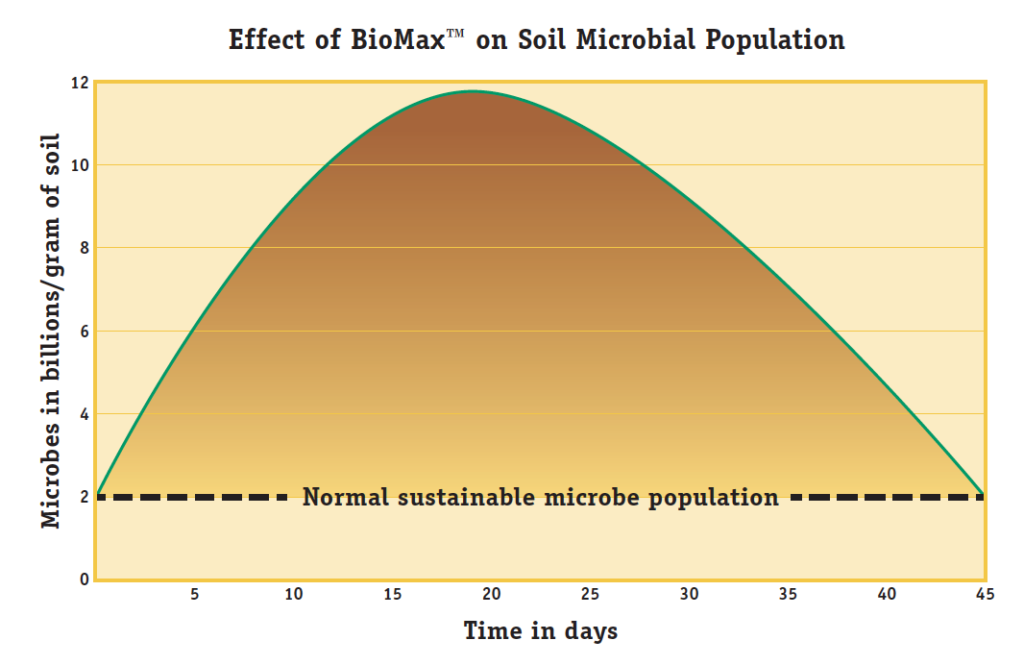 The significant additional release of carbon dioxide causes a natural aeration effect in the soil. This results in improved soil tilth, gas exchange and moisture penetration. This can be very beneficial in soils with hardpan layers and/or poorly drained or overly wet soils.
The significant additional release of carbon dioxide causes a natural aeration effect in the soil. This results in improved soil tilth, gas exchange and moisture penetration. This can be very beneficial in soils with hardpan layers and/or poorly drained or overly wet soils.
Improved population and diversity of beneficial microbes not only has a direct correlation to crop yield and quality, but also strongly compete with pathogenic soil organisms – in effect encouraging suppression of soil pathogens. In general, the greater the microbial diversity in a soil, the greater its suppressive capability.
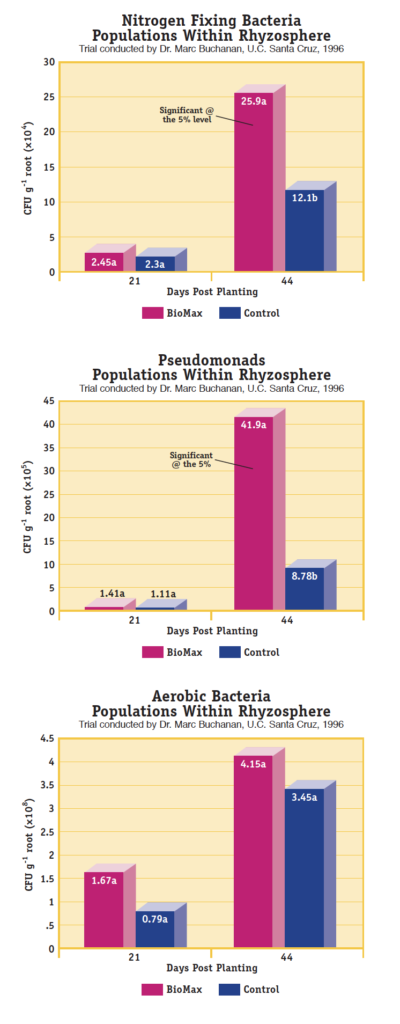 In a healthy soil system, aerobic bacteria should represent the largest microbial segment. These organisms all utilize oxygen and carbon in their metabolic processes which directly and indirectly effect plants. Their glue like exudates help to bind soil particles together – creating the beginning of “structure”. Beneficial fungi add to and reinforce the structural building process by helping to create aggregates and pores within the soil. Actinomycetes, another large group of bacteria, are responsible for that sweet smell of “silage” that a healthy soil gives off as well as for the production of antibiotics that can prevent some plant diseases. Pseudomonads are important rhyzosphere microbes that also produce various antibiotics beneficial to plant health and assist in plant feeding by converting organic compounds into plant available forms.
In a healthy soil system, aerobic bacteria should represent the largest microbial segment. These organisms all utilize oxygen and carbon in their metabolic processes which directly and indirectly effect plants. Their glue like exudates help to bind soil particles together – creating the beginning of “structure”. Beneficial fungi add to and reinforce the structural building process by helping to create aggregates and pores within the soil. Actinomycetes, another large group of bacteria, are responsible for that sweet smell of “silage” that a healthy soil gives off as well as for the production of antibiotics that can prevent some plant diseases. Pseudomonads are important rhyzosphere microbes that also produce various antibiotics beneficial to plant health and assist in plant feeding by converting organic compounds into plant available forms.
In many crops, fumigation is used to control pathogenic bacteria, fungi and nematodes. However, fumigation is indiscriminant affecting beneficial microbes also. After fumigation it is important to encourage repopulation of beneficial microbes quickly to out-compete pathogens. BioMax is an excellent tool to stimulate and increase beneficial populations. Used in conjunction with good cultural practices, (cover cropping, crop rotation, etc.), BioMax accelerates and increases microbial diversity and activity and overall soil function.
In the three charts to the right a liquid compost manufactured with BioMax™ was applied to lettuce. In addition to production improvements in the treatments, soil microbe levels where measured at different points during the trial. Rhyzosphere soil samples from the BioMax™ plots consistently showed higher levels of pseudomonads, fungi, aerobic bacteria and nitrogen-fixing bacteria.
In the soil analysis above, BioMax™ was sprayed on the pineapple residue 30 days after harvest to help accelerate residue breakdown and nutrient availability. Soil analyzes show that BioMax™ improved available macro and secondary nutrients, especially calcium, and in doing so increased the pH and cation ion exchange capacity (CEC) of the soil. These changes came as a result of BioMax™’s ability to increase microbe populations within the pineapple residue and the soil itself.
Soil health
The soil is a living system and its health is determined by the biological activity and diversity within the system. Some important health components are aeration, moisture penetration and retention and structure.
Aeration
Air pockets within soils are important as all beneficial aerobic soil organisms, microbes and roots, need oxygen to live. BioMax™ promotes soil aeration by increasing microbe populations. Higher microbial populations not only increase the total amount of respiration within the soil as microbes live and die, but also encourage activity of larger organisms, such as arthropods and earthworms, which improve soil aggregation and porosity.
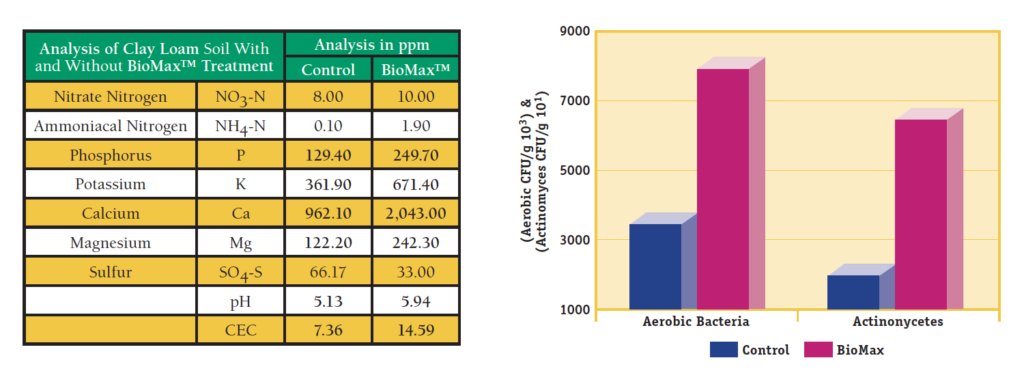 Moisture penetration & retention
Moisture penetration & retention
Better aeration within soil helps create physical space for better moisture penetration and drainage. It also improves a soils ability to hold water (retention). If soils are not properly aerated and the structure is too tight water will either not penetrate and run-off or, once soaked in, it will not drain out causing the soil to become waterlogged – a common problem in heavy clay soils.
Structure
Like aeration and water penetration and retention, it is the organisms within the soil working in harmony that build good soil structure. Air and water flow within the soil are critical building blocks of good soil structure. Bacteria and fungi populations produce compounds that help bind soil particles together to create soil aggregates. The aggregates provide internal spaces in which water and plant nutrients can be held (retention) while also providing external spaces through which water and roots can move (penetration). Soil structure is also enhanced by larger organisms like arthropods and earthworms that burrow through the soil shredding and digesting organic matter and making larger spaces as they search for bacteria and fungi.
By targeting and increasing populations of the smallest soil organisms, bacteria and fungi, BioMax™ indirectly encourages population growth of larger beneficial soil organisms like earthworms. The end result is better soil structure and ultimately better soil health.
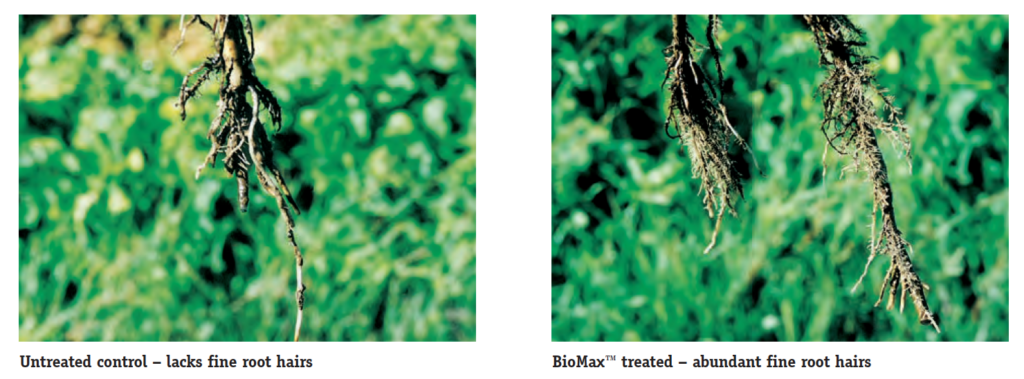
Root growth
Healthy soil that is “open” for air, nutrient and ion exchange will permit greater and healthier root growth than soils that are “tight” and lack good air, nutrient and ion exchange. BioMax™ helps create the ideal soil environment that can support rapid root growth by improving microbial populations, soil aeration, moisture penetration, moisture retention and overall structure. Furthermore, healthy soils will encourage increases in mycorrhizal fungi. These particular groups of fungi form important synergistic associations with plant roots – feeding off root exudates, mycorrhizal fungi in return supply plant available nutrients and plant growth regulators.
In the soil profile illustrations below banana root growth and root penetration is shown. Nematicides are commonly applied twice per year in the Central American banana industry. If moisture penetration decreases due to soil compaction as a result of conventional farming practices then nematicides have difficulty getting into the soil and to the target areas. In this trial BioMax™ was tested by itself to see if it could open up the soil. BioMax™ was applied at 1 quart/acre (2.5 lit./h) and the soil profile was mapped 3 months after treatment (see illustration below). In the BioMax™ treated plot increases in root umbers, weight, size, function and penetration were observed.
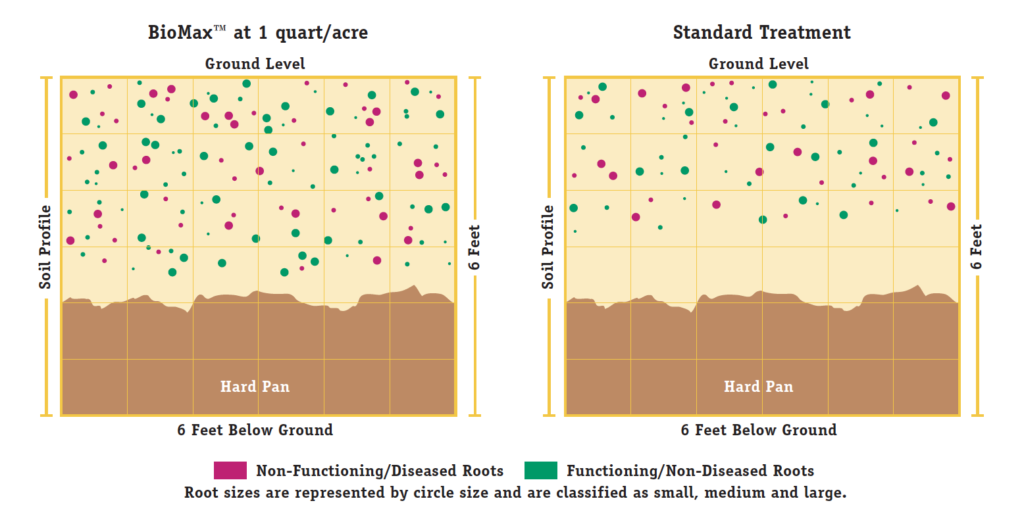
Application and cropping system recommendations
Trees, vines and berries In perennial tree, vine and berry crops, BioMax should be applied in the spring and early fall. This timing coincides with a natural increase in soil biological activity and root growth – amplifying both processes. Utilizing BioMax at these key crop timings not only helps to maximize microbial activity but also results in maximizing soil nutrient availability and total ground fertility efficiency. The best way to ensuring maximum quality and yield/acre is ensuring that nutrients are available a head of key physiological demand timings.
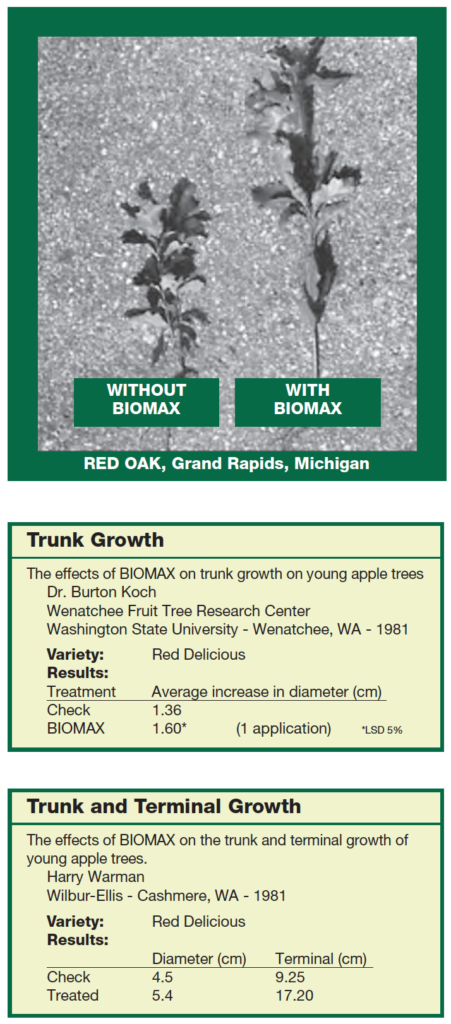
BioMax is convenient to apply. It can be applied via most irrigation systems or band-sprayed at the base of the rows. On new establishment plantings of trees, vines and berries BioMax can be applied via drip, banded and watered in or in the planting hole. Re-apply in 45 days and again in early fall via irrigation or ground spraying. Scheduled applications of BioMax on new plantings enhances the root zone conditions, creating a healthy root environment. Getting new plantings off to a good start and maximizing root development is critical to longterm productivity and improved early bearing.
Vegetables, high value cash crops and turf BioMax is particularly suitable to higher value row crops, such as vegetables, strawberries, melons, potatoes, onions, sugar beets, sweet corn, beans and alfalfa. It is also an excellent choice for turf. BioMax can be applied pre-plant during ground or bed preparation, at planting in-furrow or 2×2, or post planting via irrigation or bandsprayed and irrigated in.
Yield and quality are key factors in profitability in these crops. BioMax used pre-plant or early during the vegetative growth phase of these crops helps maximize soil available nutrients and healthy root development. Getting germinating seeds or transplants off to a vigorous start and maximizing root development is critical to potential plant productivity and quality. By encouraging microbial activity and diversity, BioMax keeps ground fertilizers more available and working longer into the season – maximizing fertilizer efficiency.

Turf and other perennial grass, hay and alfalfa crops are also excellent crops on which to utilize BioMax. Similar to tree and vine crops, applying BioMax in spring or during first irrigation, is an excellent way to maximize fall or spring applied fertilizer availability. Nutrients such as phosphorus and zinc which are instrumental in early vegetative growth and root development have limited availability when soils are cold and wet – normal spring conditions. BioMax can help turf and alfalfa overcome these conditions and get a better start in the spring.
